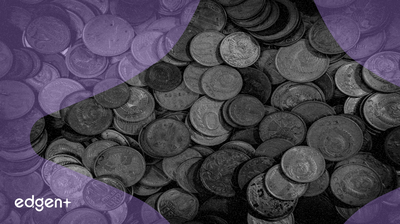Related News

Grayscale Files for NYSE IPO, Reporting $35 Billion AUM and $318.7 Million Revenue
## Executive Summary Grayscale Investments, the world's largest digital asset-focused investment platform, has formally filed for a proposed Initial Public Offering (IPO) on the New York Stock Exchange. This strategic move positions Grayscale to transition from private ownership to a public listing, reflecting a maturing digital asset market and increasing institutional interest. As of September 30, 2025, Grayscale manages approximately **$35 billion** in assets. The company reported revenue of **$318.7 million** for the nine months ended September 30, 2025, underscoring its financial scale within the digital asset sector. ## The Event in Detail Grayscale submitted its IPO filing to the U.S. Securities and Exchange Commission (SEC), appointing **Morgan Stanley**, **BofA Securities**, **Jefferies**, and **Cantor** as lead underwriters for the offering. This consortium of established financial institutions highlights the mainstream engagement with digital asset ventures. According to financial data provided in the filing, Grayscale's revenue for the nine months ended September 30, 2025, stood at **$318.7 million**, compared to **$397.9 million** for the same period in 2024. Net income for these respective periods was **$203.3 million** and **$223.7 million**. The company, founded in 2013, has pioneered regulated access to the digital asset class, offering over 40 products with exposure to more than 45 tokens, including its flagship Bitcoin product. ## Market Implications Grayscale's IPO filing is interpreted by market analysts as a significant step towards greater legitimacy and mainstream adoption for crypto assets. The move is expected to attract further institutional investment by providing a publicly traded avenue for exposure to the digital asset market. A successful IPO could encourage other crypto firms to pursue similar public offerings, building on a trend observed with companies like Figure Technologies and Gemini, which are also targeting multi-billion dollar valuations in their respective IPOs. The timing of Grayscale's offering aligns with what industry experts, such as Bitwise Chief Investment Officer Matthew Hougan, have termed a "stampede of crypto unicorn IPOs" in 2025, driven by improving crypto prices, institutional adoption, and a more favorable regulatory environment for crypto asset managers. The conversion of Grayscale's Bitcoin trust into a spot exchange-traded fund (ETF) has already boosted institutional inflows and strengthened its public-market profile, setting a precedent for this current IPO effort. ## Broader Context Grayscale's mission, "to make digital asset investing simple and open to every investor," has been central to its growth into the largest digital asset-focused investment platform globally. Its extensive suite of investment products provides investors with diverse exposure to the digital asset class. The decision to go public underscores the increasing acceptance of digital assets within traditional financial frameworks. This follows other significant public market debuts in 2025, such as stablecoin issuer Circle's SPAC transaction and crypto exchange Bullish's public listing, all of which validate the growing momentum for digital asset firms accessing public capital markets. The IPO reflects an evolving landscape where digital finance is progressively integrating into mainstream investment portfolios, moving beyond its niche origins.

Circle Launches StableFX for 24/7 On-Chain Stablecoin FX, Introduces Partner Stablecoins
## Executive Summary Circle has introduced **StableFX**, an institutional-grade foreign exchange engine now on public testnet, and **Circle Partner Stablecoins**, a new initiative to support select non-USD stablecoins. These launches on Circle's **Arc** blockchain aim to facilitate 24/7 on-chain currency trading and expand the utility of stablecoins in global financial markets. ## The Event in Detail **StableFX** is designed to provide institutions with access to and settlement of stablecoin currency pairs around the clock. The engine operates through a request-for-quote (RFQ) execution model, connecting institutions with multiple liquidity providers to ensure competitive pricing and reduced slippage. A key feature is its on-chain settlement mechanism, which ensures simultaneous payment and delivery, thereby mitigating counterparty risk. The underlying **Arc blockchain** is an open Layer-1 network specifically optimized for stablecoin finance. It leverages **USDC** as native gas for predictable, dollar-denominated fees and offers instant finality with sub-second settlement. **Arc** also incorporates opt-in privacy features with selectively shielded balances and transactions. Simultaneously, the **Circle Partner Stablecoins** program supports the deployment of non-USD stablecoins on **Arc**. Participants in this program must meet stringent eligibility standards concerning technical and operational capabilities, reserve management, and risk management. Initial collaborations are underway with entities such as Avenia (**BRLA**), Busan Digital Asset Custody Services (**KRW1**), Coins.ph (**PHPC**), Forte (**AUDF**), Juno (**MXNB**), JYPC (**JYPC**), Stablecorp (**QCAD**), and the ZAR Universal Network (**ZARU**). Circle Chief Product and Technology Officer Nikhil Chandhok stated, "With StableFX and Circle Partner Stablecoins, we're connecting the world's currencies on Arc." ## Market Implications The introduction of **StableFX** and **Circle Partner Stablecoins** is anticipated to significantly enhance the role of stablecoins in cross-border transactions and institutional finance. By providing a 24/7 on-chain foreign exchange solution, Circle addresses critical inefficiencies in traditional FX markets, such as limited operating hours and settlement delays. The on-chain settlement feature, which eliminates the risk of one party failing to deliver funds, is expected to attract greater institutional participation by reducing operational and counterparty risks. This initiative supports a broader trend towards the adoption of digital currencies for payments. Analysts at Keyrock and Bitso project that stablecoins could account for approximately **12%** of global cross-border payment volumes by **2030**. This could translate into an annual payment volume reaching **$1 trillion**, a substantial increase from less than 3% of the **$195 billion** global remittance market in 2024. The expansion to non-USD stablecoins through the Partner Stablecoins program further diversifies the utility of stablecoins beyond the primary **USDC** offering. ## Broader Context Circle's strategy with **StableFX** and **Arc** aligns with the evolving landscape of digital finance, where specialized blockchain infrastructure is being developed to meet specific financial requirements. The focus on an institutional-grade offering underscores the increasing convergence of traditional finance with blockchain technology. Furthermore, Circle's existing regulatory efforts, such as the regulation of **EURC** as one of the first fully regulated stablecoins in the European Economic Area under MiCA, demonstrate a commitment to compliance and consumer protection, which may foster greater trust and adoption for its broader stablecoin ecosystem. The mainnet launch for StableFX is planned for 2025, signaling continued development in this area.

BNY Mellon Launches Money Market Fund for Stablecoin Issuers to Comply with GENIUS Act
## Executive Summary BNY Mellon (NYSE: BK) has launched the BNY Dreyfus Stablecoin Reserves Fund (BSRXX), a money market fund tailored for U.S. stablecoin issuers. This initiative aims to ensure compliance with the Guiding and Establishing National Innovation for U.S. Stablecoins (GENIUS) Act, mandating ultra-safe investments for stablecoin reserves. ## The Event in Detail BNY Mellon, a prominent financial institution, announced the introduction of the **BNY Dreyfus Stablecoin Reserves Fund (BSRXX)**. This specialized money market fund is engineered to facilitate institutional adoption of digital assets within the liquidity sector, specifically targeting U.S. stablecoin issuers and other qualified institutional investors. The fund's design directly addresses the requirements of the **GENIUS Act**, legislation signed into law on July 18, 2025. This Act establishes a regulatory framework for payment stablecoins, stipulating that issuers of USD-backed digital tokens must invest their reserves in ultra-safe instruments. BSRXX achieves this by holding only securities with a maturity of 93 days or less, including short-term Treasury securities and overnight repurchase agreements backed by Treasury securities. Anchorage Digital, a global cryptocurrency platform, has made an initial investment in the fund, signaling early industry support for BNY Mellon's offering. ## Market Implications The launch of BSRXX underpins a significant shift towards regulatory clarity and stability within the stablecoin market. The GENIUS Act prohibits any entity other than a permitted payment stablecoin issuer from issuing stablecoins in the U.S. It further mandates that permitted issuers maintain reserves on at least a one-to-one basis, consisting solely of specified assets such as U.S. dollars, Federal Reserve notes, funds held at insured institutions, and short-term Treasuries. This regulatory environment, coupled with offerings like BSRXX, is poised to enhance confidence in stablecoins by providing a regulated and secure investment avenue for reserves. Industry analysis suggests that the stablecoin market could expand to **$1.5 trillion by 2030**, a projection influenced by increased regulatory certainty and institutional infrastructure. ## Expert Commentary **Nathan McCauley**, Co-Founder and CEO of Anchorage Digital, stated, "BNY's leadership in liquidity and the GENIUS Act framework together mark a new chapter for stablecoin infrastructure in the U.S." This sentiment underscores the perceived importance of regulated financial products in fostering the growth of digital asset ecosystems. **Stephanie Pierce**, Deputy Head of BNY Mellon Investment Management, affirmed that the fund's structure was specifically conceived to comply with the stringent requirements of the GENIUS Act, particularly concerning the short-duration nature of eligible reserve investments. ## Broader Context The introduction of BSRXX by BNY Mellon aligns with broader trends of increasing institutional engagement in digital assets. According to recent research from the Alternative Investment Management Association (AIMA) and PwC, a more constructive global regulatory environment is encouraging hedge funds and institutional investors to expand their exposure to digital assets. The **7th Annual Global Crypto Hedge Fund Report** indicates that 55% of traditional hedge funds now have some form of exposure to cryptocurrencies, an increase from 47% in 2024. Furthermore, 71% of these funds plan to increase their exposure over the next year. The interest extends to tokenization initiatives, with 33% of hedge funds actively pursuing or exploring such ventures. Over half (52%) of all respondents express interest in tokenized fund structures, citing potential benefits in broader investor access and operational efficiencies. BNY Mellon's latest offering contributes to this evolving landscape by providing foundational infrastructure crucial for compliant institutional participation in the digital asset space.
